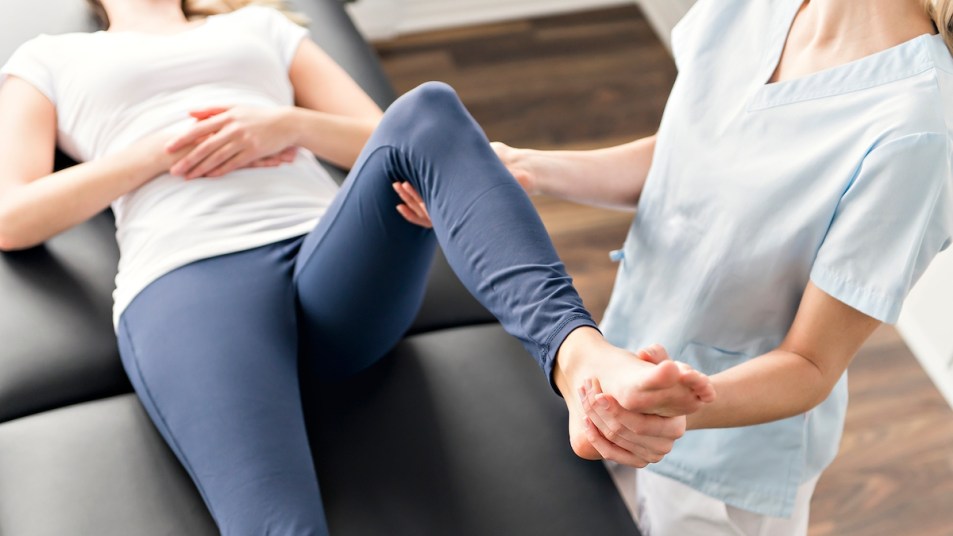Professional Stretching Is the Latest 50-Plus TikTok Trend — But What Is It?
Stretch your best.

If you’re physically active, you already know the importance of stretching before and after your workout. Stretching boasts a variety of health benefits: It can increase flexibility, improve posture, ease back pain, and relieve stress. The problem with stretching, though, is that many of us forget to do it. And even when we do incorporate it into our routine, we may be doing it incorrectly. That’s why a surprising solution has become increasingly popular in recent years: professional stretching. That’s right — you can get stretched out by an expert. Read on to learn what that means and how it might benefit you.
What is professional stretching?
Think of professional stretching — also known as stretch therapy or assisted stretching — as a form of physical therapy or personal training. Professional stretching is popular at stretch studios like StretchLab, Stretch Zone, and Stretch*d, and these days you can even access professional stretching services at ubiquitous chains like Massage Envy. The stretching sessions vary in length and cost, but they generally last at least 30 minutes and cost somewhere from $40 to $100.
During a typical stretch therapy session, you’ll share information with your therapist about your fitness routine, any pain or stiffness you’re dealing with, and concerns specific to stretching. The therapist will then guide you through a tailored series of stretches, holding your body and using specialized equipment (like a table with a strap) as they guide you through the motions. Getting stretched by a therapist allows you to get a deeper stretch than you normally would, and learn how to move your body for the best on-your-own stretch possible. The therapist will also give you a selection of stretches to practice at home, along with pointers on how to do them properly.
How can stretching benefit mature women?
If you’re the kind of person who likes trying out the latest wellness trends, you might be enticed to book a professional stretching session. However, many stretch studios recommend you commit to doing sessions regularly — and the cost can definitely add up. According to CNN, “the jury is out whether assisted stretching is better than unassisted stretching.” So, whether you stretch with the assistance of a therapist or on your own without the help of a studio, it’s sure to benefit your body and mind.
Research backs up the benefits: A small study in Clinical Interventions in Aging showed that an eight-week assisted stretching program improved elderly participants’ range of motion and offered a valuable way for them to stay active without doing high-intensity exercise. Another study, in the Journal of Strength and Conditioning Research, showed the effectiveness of stretching in improving older adults’ range of motion.
Stretching may even have a positive impact on menopausal issues; a study in the journal Menopause suggested that 10 minutes of stretching before bed decreased menopausal and depressive symptoms in the women who participated. It’s also recommended for those who want to mitigate symptoms of osteoporosis (a condition that’s far more common in women). Given that our posture can worsen with age, the posture-improving potential of stretching feels particularly relevant. And best of all, it’s a lot less intimidating than a high-impact workout!
How can I translate the benefits of professional stretching to home stretching?
Even a little bit of stretching can go a long way, yet many people overlook it. As Stretch*d co-founder Vanessa Chu says, “it’s like the flossing of fitness” — while valuable for our health, it’s also easy to ignore or forget. Try to carve out the time and space to stretch; it may help to do it when you wake up or right before you go to bed. There are many stretches you can try without the assistance of a professional.
How To: Closed Figure-4 Stretch
Hayley Lubow, a stretch therapist, says that a closed figure-4 stretch is the move that tends to be the most broadly beneficial for her clients. This stretch can be done seated or while lying down. Here’s how to do it, with steps adapted from Well+Good.
If you’re lying down:
- Lie on your back with both knees bent and the soles of your feet flat on the floor.
- Bend your right knee in a right angle and place your right ankle over your left knee with your foot flexed.
- Interlace both hands under your left thigh and pull your left thigh with your right ankle on top in toward your chest. If you find that your back is rounding and your spine isn’t flat on the floor, grab a stretch rope or a towel to wrap under your thigh instead of your hands, giving you more leverage and making the stretch more comfortable.
- Gently release your legs down (maintaining this shape) but keep your grip. You’ll need a few more reps for the stretch to really make a difference in your body.
- Repeat four to five times, then switch sides.
If you’re seated:
- Sit with upright posture on your chair with your feet planted firmly on the ground.
- Lift your right leg up and place your right ankle on top of your left thigh, right above the knee. You can place your right hand above the raised knee to get a little more leverage, but be gentle with it.
- Start to slowly lean forward with a straight spine. When you find your end range, relax into it for a few seconds then slowly sit back up.
- Repeat four to five times, then switch sides.
Can’t quite picture how the stretch is done? Watch the video below to see it in action.
No matter what your fitness routine is like, it’s always worth adding a few stretches into the mix. Practice stretching regularly, at home or in a studio with a professional, and you just might find you stand up a little straighter and feel more confident every day.













